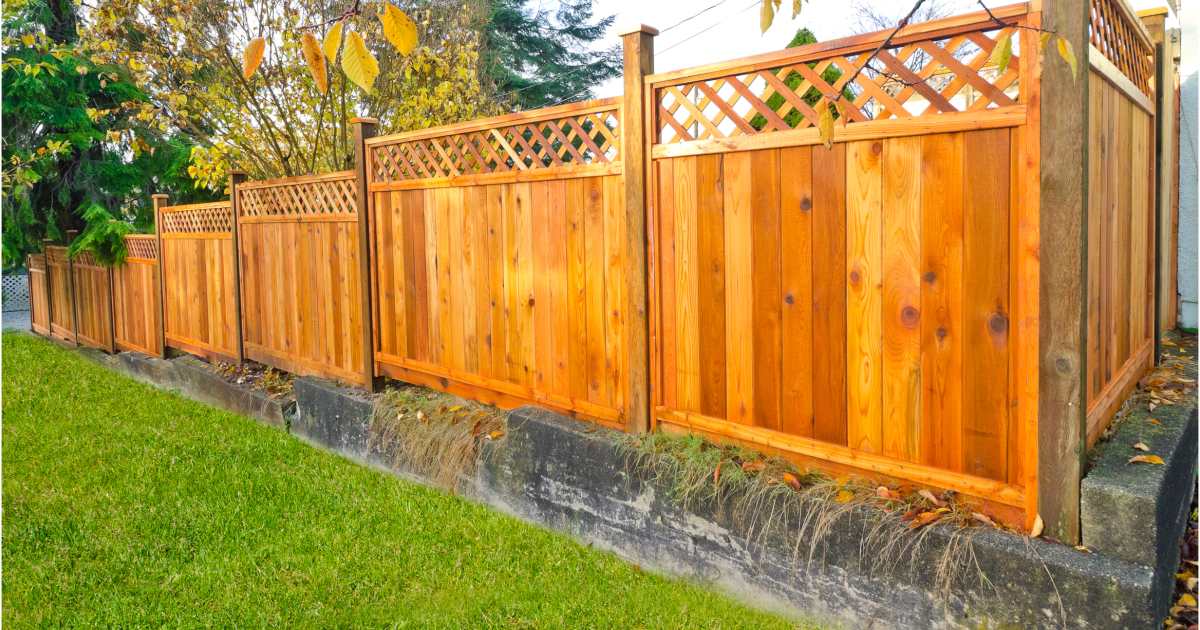All Categories
Featured
Your fencing is exposed to different climate conditions year-round, and while it offers as a necessary part of your property, it's additionally one of the most vulnerable aspects when it comes to weather-related damage. Below are some reliable techniques to safeguard your fence from weather-related damage.
Wooden Fences: While timber is a timeless selection for secure fencing, it is prone to rot, insect, and bending damage, specifically in areas with high dampness. Pressure-treated timber or cedar is more long lasting, yet routine maintenance is necessary to maintain it in excellent problem. Plastic Fencing: Vinyl is an exceptional option for those trying to find a weather-resistant and low-maintenance fencing. It's unsusceptible moisture, will not warp or fracture in the warm, and stands up to fading from UV rays. Metal Secure fencing: Wrought iron and light weight aluminum are durable materials for fence, but they need a rust-resistant finishing to protect them from corrosion due to dampness. A safety finish or normal maintenance can avoid rust and expand the life of steel fencings. Composite Fence: Made from a blend of wood fibers and plastic, composite fencings are extremely resistant to weather elements, including uv, dampness, and heat rays. This material offers a balance of toughness and visual allure. Choosing a product matched to your climate will certainly supply far better defense for your fence in the lengthy term.
Seal or Tarnish the Timber: Applying a high-quality sealer or discolor to your wood fencing produces a water resistant obstacle that protects against moisture from entering the timber. It additionally aids secure the timber from UV rays, which can cause discoloration and drying. Reapply Sealant Consistently: Over time, the safety obstacle of your sealant or stain can put on down. Depending upon your environment, it's a good idea to reapply each to two years to maintain the wood protected. This treatment will certainly maintain the fencing's look, protect against rot, and lengthen its life expectancy.
![]()
For additional protection, take into consideration using wind-resistant mesh displays or panels in areas where wind is a considerable concern. This additional layer can assist lessen the pressure that the wind puts in on your fence.
Check Drainage: Guarantee that the ground around your fencing slopes far from the messages. Appropriate drainage allows water to move far from the fence, avoiding dampness build-up. Install Water Drainage Solutions: In areas where drain is a problem, take into consideration including a French drain or crushed rock around the base of your fencing posts to reroute water far from the structure. Good drain can stop rot, rust, and other forms of weather-related damage.
![]()
![]()
Concrete Footings: Set fencing articles in concrete to stop them from loosening up over time because of dirt erosion or moving ground. Metal Dental Braces: Adding metal dental braces to fencing posts can give added toughness and minimize the threat of damaging or leaning. Strengthening your posts ensures that your fence will remain in area, even throughout extreme weather condition.
For wooden fencings, carefully wash the surface with a moderate cleaning agent to eliminate dust and grime. For plastic fences, make use of a soft cloth and cleaning option to protect against accumulation. For steel fencings, evaluate for corrosion and sand it off before applying a fresh coat of paint. Final thought. Your fencing is an important function of your residential property, and with the ideal treatment, it can stand up to the obstacles posed by the weather. By choosing durable materials, executing routine maintenance, and strengthening weak factors, you can secure your fence from the aspects and expand its life. Regular evaluations, applying protective finishes, and taking actions to manage moisture and wind direct exposure will certainly assist guarantee that your fencing continues to be strong, functional, and attractive for several years ahead.
- Select Weather-Resistant Products. The products you pick for your fence can have a significant influence on its capability to hold up against the elements. Various products are much better outfitted to manage specific climate condition. Below's a malfunction of how different materials stand up versus the weather condition:
Wooden Fences: While timber is a timeless selection for secure fencing, it is prone to rot, insect, and bending damage, specifically in areas with high dampness. Pressure-treated timber or cedar is more long lasting, yet routine maintenance is necessary to maintain it in excellent problem. Plastic Fencing: Vinyl is an exceptional option for those trying to find a weather-resistant and low-maintenance fencing. It's unsusceptible moisture, will not warp or fracture in the warm, and stands up to fading from UV rays. Metal Secure fencing: Wrought iron and light weight aluminum are durable materials for fence, but they need a rust-resistant finishing to protect them from corrosion due to dampness. A safety finish or normal maintenance can avoid rust and expand the life of steel fencings. Composite Fence: Made from a blend of wood fibers and plastic, composite fencings are extremely resistant to weather elements, including uv, dampness, and heat rays. This material offers a balance of toughness and visual allure. Choosing a product matched to your climate will certainly supply far better defense for your fence in the lengthy term.
- Consistently Treat Wood Fencings. Securing it from sunshine, dampness, and temperature level fluctuations is important if you have a wooden fencing. Timber can soak up wetness from snow, rainfall, or moisture, causing it to rot and weaken. Here's just how you can secure wooden fencings:
Seal or Tarnish the Timber: Applying a high-quality sealer or discolor to your wood fencing produces a water resistant obstacle that protects against moisture from entering the timber. It additionally aids secure the timber from UV rays, which can cause discoloration and drying. Reapply Sealant Consistently: Over time, the safety obstacle of your sealant or stain can put on down. Depending upon your environment, it's a good idea to reapply each to two years to maintain the wood protected. This treatment will certainly maintain the fencing's look, protect against rot, and lengthen its life expectancy.

- Install Windbreaks. Strong winds can trigger significant damage to fences, particularly those constructed from tall frameworks or light-weight materials. Wind can fall a fencing or trigger panels to change. Setting up a windbreak is an efficient way to decrease the effect of gusty winds. You can produce a windbreak by growing shrubs, trees, or tall plants near your fence. These natural barriers can assist deflect wind, stopping direct gusts from harming your fence.
For additional protection, take into consideration using wind-resistant mesh displays or panels in areas where wind is a considerable concern. This additional layer can assist lessen the pressure that the wind puts in on your fence.
- Guarantee Proper Water Drainage Around Your Fencing. Standing water is among the leading reasons of fence damages, particularly for wooden fences. Water can deteriorate the fence articles, triggering them to rot and deteriorate much more rapidly. To stop this:
Check Drainage: Guarantee that the ground around your fencing slopes far from the messages. Appropriate drainage allows water to move far from the fence, avoiding dampness build-up. Install Water Drainage Solutions: In areas where drain is a problem, take into consideration including a French drain or crushed rock around the base of your fencing posts to reroute water far from the structure. Good drain can stop rot, rust, and other forms of weather-related damage.

- Trim Overhanging Branches and Vines. Trees and plants near your fencing might feel like an attractive enhancement, but they can position risks when left unattended. Looming tree branches and vines can cause damages to your fencing throughout tornados or high winds. In addition, creeping plants can trap moisture against wood fences, quickening the decomposing procedure. To shield your fencing, trim any branches or plants that hang over or near the fence routinely. This will lessen the possibility of dropping particles and avoid wetness buildup.
- Enhance Fence Posts. Fence messages are susceptible to changing, leaning, and decaying, especially throughout periods of extreme weather. If your fencing is in a location that experiences high winds or freezes during wintertime, it's crucial to strengthen the blog posts to preserve security.

Concrete Footings: Set fencing articles in concrete to stop them from loosening up over time because of dirt erosion or moving ground. Metal Dental Braces: Adding metal dental braces to fencing posts can give added toughness and minimize the threat of damaging or leaning. Strengthening your posts ensures that your fence will remain in area, even throughout extreme weather condition.
- Routine Inspections and Maintenance. Inspect your fence after storms or heavy rainfall to look for problems such as loosened boards, sagging messages, or rusted areas. Additionally, cleansing your fencing occasionally assists maintain its problem.
For wooden fencings, carefully wash the surface with a moderate cleaning agent to eliminate dust and grime. For plastic fences, make use of a soft cloth and cleaning option to protect against accumulation. For steel fencings, evaluate for corrosion and sand it off before applying a fresh coat of paint. Final thought. Your fencing is an important function of your residential property, and with the ideal treatment, it can stand up to the obstacles posed by the weather. By choosing durable materials, executing routine maintenance, and strengthening weak factors, you can secure your fence from the aspects and expand its life. Regular evaluations, applying protective finishes, and taking actions to manage moisture and wind direct exposure will certainly assist guarantee that your fencing continues to be strong, functional, and attractive for several years ahead.
Latest Posts
Check Out the Greatest Auto Repair Deals in Montclare, Chicago
Published May 29, 25
1 min read
Take Advantage of Limited-Time Auto Repair Offers in Chicago at Montclare Auto Repair
Published May 29, 25
1 min read
Explore Cut Costs on Car Maintenance with Montclare Auto Repair’s Special Deals
Published May 25, 25
1 min read
More
Latest Posts
Check Out the Greatest Auto Repair Deals in Montclare, Chicago
Published May 29, 25
1 min read
Take Advantage of Limited-Time Auto Repair Offers in Chicago at Montclare Auto Repair
Published May 29, 25
1 min read
Explore Cut Costs on Car Maintenance with Montclare Auto Repair’s Special Deals
Published May 25, 25
1 min read